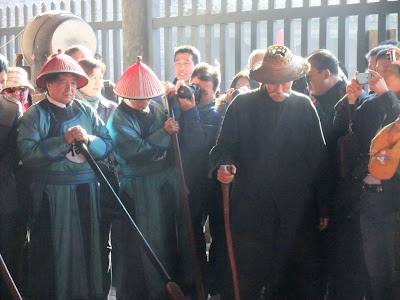
The Pingyao County Government Office (衙门) located in the middle of Zhengfu (Yamen) Street was one of the 18 most important historical sites in Pingyao Ancient City. It shows a complete picture of the solemn law court and prison of the Qing Dynasty. Yemen Office was first built in late Yuan Dynasty (1271-1368) and rebuilt in Ming Dynasty (1368-1644). The office complex covered a total land area of 22,660 sq. meter and comprised of several complicated architectures like memorial archway, the 3 gates, 3 lobbies and 5 halls.



Pingyao Town was the county seat in the past and the county Yamen served as an office to local government. The principal structure in the County Government office complex was a court hall and by the east side of the court hall was the Councillor house used by ministry officers to seek advices from former officials and a ceremonial house that used to store ceremonial related items is by its east side.



The court hall facing south direction of the complex, served as a court room where officers held grand ceremony and cognizance serious cases. This was a place to hold major activities.



The County Government Office known as Yemen in Chinese is now a museum. The daily performance in the museum showing the procedure of how the magistrate handled a court case in the court hall, attracted crowds of people.


The County Magistrate.




Seated at the side table was we called a prosecutor.



Today's performance was a show of a 14th century trial about a son not supporting his father. The plaintiff of the case was an old man sued his wealthy son for treating him badly.


The Plaintiff brought out some incidents to prove that his son not treated him as a father and chased him out of the house.



The rich young man, the son of the plaintiff was brought into the court hall and had dialogue with his father.




The son failed in self defensing. The magistrate convicted him with 18 strokes by wooden planks.



Once the case was closed, the prosecutor would asked for thumb print from the plaintiff as well as the defendant.



Taking the advice of the Prosecutor not to hurt his father again, the son brought his father back home. Happy ending!



These are office rooms for the 6 departments corresponding to the central government. Military affair was handled by west offices and east offices handled administrative matter.


The residence of County magistrate was within the inner courtyard.


There was also a smaller court hall inside the courtyard to handle petite cases of family affairs.


Many pillars of the architectural structures were inscribed with couplet composed by the officials to show off and outstanding their exclusive personality and high morality.




A tea room and an illustration showing what they took for breakfast, lunch and dinner plus the banquet dishes they normally treated their senior officers.


There are a pair of Pagoda trees with a history of 600 years. It was said that the trees were the 6th generation of the first tree that was planted during Han Dynasty. The tree grew up, died off then rejuvenated, until what it is today


The unique part about the structure of the theater or stage platform was its archway that served as a through pathway from one courtyard to the other.



There is a temple specially built for The Great Deity which was said to be a fairy fox. Majority of the Qing Ministry officers worship The Great Deity as it was believed that the deity had the power to protect their post and future promotion, and if you offended him, you would be hurt.


No comments:
Post a Comment